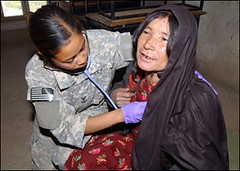By Sgt. Nina J. Ramon
345th Mobile Pubic Affairs Detachment
BAGRAM AIRFIELD, Afghanistan – Coalition forces, to include the Bagram Cooperative Medical Assistance team and New Zealand Provincial Reconstruction team, conducted a joint medical civil action program July 22 to 29 in the Panjab and Waras districts of Bamyan Province.
During the visits to the Tarapass and Petabjoy valley systems, the combined team stopped at local medical centers before traveling to schools to provide medical support to villagers.
The medical centers visited included Panjab District Hospital, the biggest hospital in the area, and the Shinya Ashkarat Clinic of Basic Health Care.
“We provide training best needed for problems and concerns in the area,” said Army Maj. Anthony Littrell, CMA director from Samford, N.C. “The area is inaccessible nine months out of the year due to harsh weather conditions. Because of this, non-urgent cases can be treated at individual homes by community health workers.” {Click on image for photo details}

1 comment:
Coalition medical professionals spoke with the doctors and midwives, discussing ways to improve care in the area, particularly during the harsh seasons.
New Zealand team medics mentored community health workers to improve basic first-aid skills so community health workers can take those basic skills into the villages to educate the people and offer medical assistance.
“We are here to assess the health care needs of the local population – people who are not able to visits clinics,” said Littrell. “We’re also providing humanitarian aid supplies including hygiene, school and first-aid kits, along with vegetable oil and bags of beans, rice and salt.”
The medical teams also traveled to various schools, including the Tarapass and Binigaw schools, where local villagers received basic medical checkups and treatment. The team treated more than 5,500 patients over a three-day visit.
Along with treating villagers in each area, CMA team veterinarians vaccinated and de-wormed roughly 3,000 animals.
According to Army Maj. Jessica McCoy, the CMA team’s veterinarian from Wellesley, Mass., an average herd consists of 60 to 80 animals.
“Everything went smoothly,” said New Zealand Maj. Rob Francis, Kiwi team patrol commander. “The only thing that posed a challenge was the large number of people that showed up, which is a good problem to have.”
Post a Comment